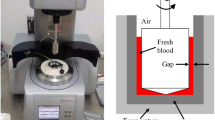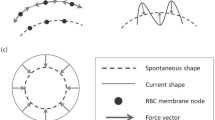Abstract
Flow-induced damage to red blood cells has been an issue of considerable importance since the introduction of the first cardiovascular devices. Early blood damage prediction models were based on measurements of damage by shear stress only. Subsequently, these models were extrapolated to include other components of the fluid stress tensor. However, the expanded models were not validated by measurements of damage in response to the added types of stress. Recent investigations have proposed that extensional stress might be more damaging to red cells than shear stress. In this study, experiments were conducted to compare human red cell deformation under laminar extensional stress versus laminar shear stress. It was found that the deformation caused by shear stress is matched by that produced by an extensional stress that is approximately 34 times smaller. Assuming that blood damage scales directly with cell deformation, this result indicates that mechanistic blood damage prediction models should weigh extensional stress more than shear stress.










Similar content being viewed by others
Notes
The stress used here is the axial extensional stress \(\sigma_{zz} ,\) whereas Lee et al. (2009) applied the Trouton extensional viscosity (Trouton 1906), which is defined as the ratio of the principal stress difference \(\sigma_{1} - \sigma_{3}\) to the extension rate for uniaxial extension, where the subscripts correspond to the principal axes. By continuity for an incompressible fluid, the extension rates along the second and third axes are -1/2 times the extension rate along the first axis. Therefore, for a Newtonian fluid, the Trouton extensional viscosity is 3 times the shear viscosity. For planar extension, such as in the hyperbolic contractions used in this work and that of Lee et al. (2009), there are two extensional viscosities. One, the planar extensional viscosity, is the ratio of \(\sigma_{1} - \sigma_{3}\) to the extension rate, which is 4 times the shear viscosity. The second extensional viscosity, or cross-viscosity, is the ratio of \(\sigma_{2} - \sigma_{3}\) to the extension rate, where axis 2 is that along which there is zero deformation. The cross-viscosity is 2 times the shear viscosity.
References
Basu H, Dharmadhikari AK, Dharmadhikari JA, Sharma S, Mathur D (2011) Tank treading of optically trapped red blood cells in shear flow. Biophys J 101:1604–1612. https://doi.org/10.1016/j.bpj.2011.08.043
Blackshear PLJ, Dorman FD, Steinbach JH (1965) Some mechanical effects that influence hemolysis. ASAIO J 11:112–117
Bludszuweit C (1995) Model for a general mechanical blood damage prediction. Artif Organs 19:583–589
Brown CHI, Lemuth RF, Hellums JD, Leverett LB, Alfrey CP (1975) Response of human platelets to shear stress. ASAIO J 21:35–39
Chen Y, Sharp MK (2011) A strain-based flow-induced hemolysis prediction model calibrated by in vitro erythrocyte deformation measurements. Artif Organs 35:145–156. https://doi.org/10.1111/j.1525-1594.2010.01050.x
Ding J, Niu S, Chen Z, Zhang T, Griffith BP, Wu ZJ (2015) Shear-induced hemolysis: species differences. Artif Organs 39:795–802. https://doi.org/10.1111/aor.12459
Down LA, Papavassiliou DV, O’Rear EA (2011) Significance of extensional stresses to red blood cell lysis in a shearing flow. Ann Biomed Eng 39:1632–1642. https://doi.org/10.1007/s10439-011-0262-0
Dupire J, Socol M, Viallat A (2012) Full dynamics of a red blood cell in shear flow. Proc Natl Acad Sci USA 109:20808–20813. https://doi.org/10.1073/pnas.1210236109
Faghih MM, Sharp MK (2016) Extending the power-law hemolysis model to complex flows. J Biomech Eng 138:12. https://doi.org/10.1115/1.4034786
Faghih MM, Sharp MK (2018a) Characterization of erythrocyte membrane tension for hemolysis prediction in complex flows. Biomech Model Mechanobiol 17:827–842. https://doi.org/10.1007/s10237-017-0995-2
Faghih MM, Sharp MK (2018b) Solvent-based bonding of PMMA-PMMA for microfluidic applications. Microsyst Technol. https://doi.org/10.1007/s00542-018-4266-7
Faghih MM, Sharp MK (2019a) Modeling and prediction of flow-induced hemolysis: a review. Biomech Model Mechanobiol. https://doi.org/10.1007/s10237-019-01137-1
Faghih MM, Sharp MK (2019b) Evaluation of energy dissipation rate as a predictor of mechanical blood damage. Artif Organs 43:666–676. https://doi.org/10.1111/aor.13418
Fedosov DA, Caswell B, Karniadakis GE (2010) A multiscale red blood cell model with accurate mechanics, rheology, and dynamics. Biophys J 98:2215–2225. https://doi.org/10.1016/j.bpj.2010.02.002
Fischer TM (2007) Tank-tread frequency of the red cell membrane: dependence on the viscosity of the suspending medium. Biophys J 93:2553–2561. https://doi.org/10.1529/biophysj.107.104505
Fischer TM, Stohr-Lissen M, Schmid-Schonbein H (1978) The red cell as a fluid droplet: tank tread-like motion of the human erythrocyte membrane in shear flow. Science 202:894–896
Giersiepen M, Krause U, Knott E, Reul H, Rau G (1989) Velocity and shear stress distribution downstream of mechanical heart valves in pulsatile flow. Int J Artif Organs 12:261–269
Heuser G, Opitz R (1980) A Couette viscometer for short time shearing of blood. Biorheology 17:17–24
Keshaviah PR (1976) Hemolysis in the accelerated flow region of an abrupt contraction. PhD thesis, University of Minnesota
Khoo DPY, Cookson AN, Gill HS, Fraser KH (2018) Normal fluid stresses are prevalent in rotary ventricular assist devices: a computational fluid dynamics analysis. Intl J Artif Organs 41(11):738–751
Laugel JF, Beissinger RL (1983) Low stress shear-induced hemolysis in capillary flow. Trans Am Soc Artif Intern Organs 29:158–162
Lee SS, Yim Y, Ahn KH, Lee SJ (2009) Extensional flow-based assessment of red blood cell deformability using hyperbolic converging microchannel. Biomed Microdevices 11:1021–1027. https://doi.org/10.1007/s10544-009-9319-3
Leverett LB, Hellums JD, Alfrey CP, Lynch EC (1972) Red blood cell damage by shear stress. Biophys J 12:257–273
Mohandas N, Clark MR, Jacobs MS, Shohet SB (1980) Analysis of factors regulating erythrocyte deformability. J Clin Invest 66:563–573
Namdee K, Carrasco-Teja M, Fish MB, Charoenphol P, Eniola-Adefeso O (2015) Effect of variation in hemorheology between human and animal blood on the binding efficacy of vascular-targeted carriers. Sci Rep 5:11631. https://doi.org/10.1038/srep11631
Nevaril CG, Lynch EC, Alfrey CP Jr, Hellums JD (1968) Erythrocyte damage and destruction induced by shearing stress. J Lab Clin Med 71:784–790
Ober TJ, Haward SJ, Pipe CJ, Soulages J, McKinley GH (2013) Microfluidic extensional rheometry using a hyperbolic contraction geometry. Rheol Acta 52:529–546
Oliveira M, Alves MA, Pinho FT, McKinley GH (2007) Viscous fluid flow through microfabricated hperbolic contractions. Exp Fluids 43:437–451. https://doi.org/10.1007/s00348-007-0306-2
Pfafferott C, Nash GB, Meiselman HJ (1985) Red blood cell deformation in shear flow. Effects of internal and external phase viscosity and of in vivo aging. Biophys J 47:695–704. https://doi.org/10.1016/S0006-3495(85)83966-7
Richardson E (1974) Deformation and haemolysis of red cells in shear flow. Proc R Soc Lond A Math Phys Eng Sci 338:129–153. https://doi.org/10.1098/rspa.1974.0078
Sallam AM, Hwang NH (1984) Human red blood cell hemolysis in a turbulent shear flow: contribution of Reynolds shear stresses. Biorheology 21:783–797
Sousa PC, Pinho FT, Oliveira MS, Alves MA (2011a) Extensional flow of blood analog solutions in microfluidic devices. Biomicrofluidics 5:14108. https://doi.org/10.1063/1.3567888
Sousa PC, Pinho IS, Pinho FT, Oliveira MSN, Alves MA (2011b) Flow of a blood analogue solution through microfabricated hyperbolic contractions. In: Tavares SJMR, Jorge NRM (eds) Computational vision and medical image processing: recent trends. Springer, Dordrecht, pp 265–279. https://doi.org/10.1007/978-94-007-0011-6_15
Tran-Son-Tay R, Sutera SP, Zahalak GI, Rao PR (1987) Membrane stress and internal pressure in a red blood cell freely suspended in a shear flow. Biophys J 51:915–924. https://doi.org/10.1016/s0006-3495(87)83419-7
White FM (1991) Viscous fluid flow. McGraw-Hill, New York
Yen J-H, Chen S-F, Chern M-K, Lu P-C (2015) The effects of extensional stress on red blood cell hemolysis. Biomed Eng Appl Basis Commun 27:1550042. https://doi.org/10.4015/S1016237215500428
Zhang T, Taskin ME, Fang H-B, Pampori A, Jarvik R, Griffith BP, Wu ZJ (2011) Study of flow-induced hemolysis using novel Couette-type blood-shearing devices. Artif Organs 35:1180–1186. https://doi.org/10.1111/j.1525-1594.2011.01243.x
Author information
Authors and Affiliations
Corresponding author
Additional information
Publisher's Note
Springer Nature remains neutral with regard to jurisdictional claims in published maps and institutional affiliations.
Rights and permissions
About this article
Cite this article
Faghih, M.M., Sharp, M.K. Deformation of human red blood cells in extensional flow through a hyperbolic contraction. Biomech Model Mechanobiol 19, 251–261 (2020). https://doi.org/10.1007/s10237-019-01208-3
Received:
Accepted:
Published:
Issue Date:
DOI: https://doi.org/10.1007/s10237-019-01208-3




